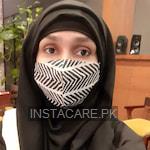Rubeola - Symptoms, Risk factors and Treatment
Last Updated On Friday, January 9, 2026
Rubeola in Urdu
Rubeola، جسے خسرہ بھی کہا جاتا ہے، ایک انفیکشن ہے جو عام طور پر بچپن میں ہوتا ہے۔ اب، اپنے آپ کو اس کے خلاف ویکسین کروا کر اس سے بچا جا سکتا ہے۔ چھوٹے بچوں کے لئے، یہ مہلک ہو سکتا ہے. یہ ایک وائرل انفیکشن ہے جو ایک وائرس کی وجہ سے ہوتا ہے جو گلے اور پھیپھڑوں کے استر والے خلیوں کے اندر بڑھتا ہے۔
خسرہ ایک بہت ہی متعدی بیماری ہے، جس کا مطلب ہے کہ یہ متاثرہ شخص سے صحت مند تک تیزی سے پھیلتا ہے۔ یہ سانس کی بوندوں کے ذریعے پھیل سکتا ہے۔ جب بھی کوئی متاثرہ شخص کھانستا ہے یا چھینکتا ہے تو وہ برونائیل رطوبتیں خارج کرتے ہیں۔ ان سانس کی رطوبتوں کے ساتھ رابطے میں آنے والا ایک صحت مند شخص انفیکشن کا شکار ہو سکتا ہے۔ اس لیے خسرہ والے شخص کو خود کو الگ تھلگ کرنے کے لیے کہا جانا چاہیے۔
اس سے کھانسی، بخار، ناک بہنا، خارش اور سستی ہوتی ہے۔ روبیولا کی خصوصیت ٹیل ٹیل ریش ہے۔ اگر علاج نہ کیا جائے تو یہ نمونیا، کان میں انفیکشن، اور دماغ کی سوزش جیسی پیچیدگیوں کا باعث بن سکتا ہے- ایک ایسی حالت جسے انسیفلائٹس کہتے ہیں۔
Rubeola in English
Rubeola, also known as measles, is an infection that usually occurs in childhood. Now, it is preventable by getting yourself vaccinated against it. For small children, it can be fatal. It is a viral infection that occurs due to a virus that grows inside the cells lining the throat and lungs.
Measles is a very contagious disease, which means it spreads rapidly from the infected person to the healthy one. It can spread through respiratory droplets. Whenever an infected person coughs or sneezes, they emit out bronchial secretions. A healthy person getting in contact with those respiratory secretions can get the infection. Therefore, the person having measles should be asked to isolate themselves.
It causes cough, fever, runny nose, rashes, and lethargy. The characteristic feature of rubeola is telltale rash. If left untreated, it can lead to complications like pneumonia, ear infections, and inflammation of the brain- a condition called encephalitis.
Symptoms
The symptoms of rubeola occur between 1 to 14 days after getting exposed to the virus. Its common symptoms are;
- Fever
- Dry cough
- Runny nose
- Sore throat
- Inflamed eyes- conjunctivitis
- Koplik’s spots- tiny white spots with bluish-white centers on a red background found inside the mouth on the inner lining of the cheek
- Large skin rashes that often flow into one another
Stages
The rubeola infection has stages that can be described as;
Incubation period- this is the time period when the virus incubates inside your body. It has a duration of 10 to 14 days and occurs after getting exposed to the virus. The virus shows no signs and symptoms at this stage.
Nonspecific signs and symptoms- at this stage, the infection presents with cough, runny nose, and fever. The symptoms resemble the general illness, and it lasts for 2 to 3 days.
Acute illness accompanied with rashes- the severity of symptoms increase, and rashes also start to occur. Fever may rise to 104 degrees Fahrenheit. Spots and rashes start to cover up your body.
Communicable period- after the symptoms resolve, you can still transmit measles to other people. Therefore you should remain in isolation until all the rashes disappear.
Causes
It is a viral infection that occurs due to a virus that grows inside the cells lining the throat and lungs. Measles is a very contagious disease, which means it spreads rapidly from the infected person to the healthy one. It can spread through respiratory droplets. Whenever an infected person coughs or sneezes they emit out bronchial secretions. A healthy person getting in contact with those respiratory secretions can get the infection. If an infected person leaves their virus-containing bronchial secretions at a surface after coughing, the healthy person if touches the same surface and puts their fingers in the eyes, nose, or mouth, they can get infection too. Therefore, a person having measles should be asked to isolate themselves.
Risk factors
The risk factors for measles are;
- Being unvaccinated
- Traveling to places where rubeola is prevalent
- Having vitamin A deficiency
Complications
Rubeola, if left untreated, can lead to various complications. It can cause;
- Ear infections
- Pneumonia
- Bronchitis
- Croup
- Laryngitis
- Encephalitis
- Pregnancy problems- low birth weight, preterm labor, and maternal death
Prevention
- Rubeola can be prevented by two basic techniques;
- Isolating yourself from healthy people during the infectious period for at least 10 to 14 days
- Getting you and your family vaccinated against it. Make sure your child receives it during their childhood period.
Treatment
The healthcare providers treat rubeola symptomatically. They may give over-the-counter pain relievers for lethargy and fatigue and paracetamol to treat fever.
Conclusion
Rubeola, also known as measles, is an infection that usually occurs in childhood. Now it is preventable by getting yourself vaccinated against it. For small children, it can be fatal. It is a viral infection that occurs due to a virus that grows inside the cells lining the throat and lungs. Measles is a very contagious disease.









